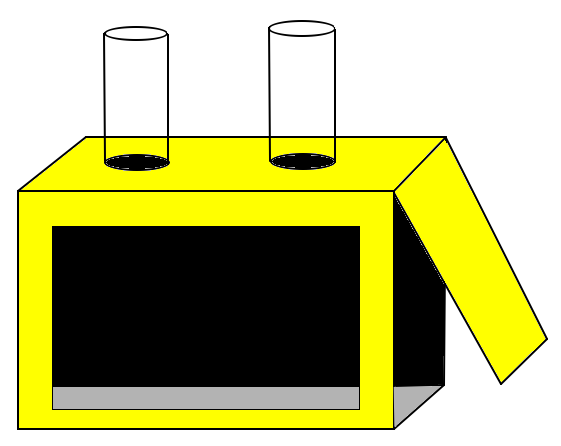Convection Currents
Convection is an important physical process that relates to the differential heating, and therefore density differences, that give rise to movement of fluids like air and water. We can see convection happening in a pot on the kitchen stove, in the rise and fall of a hot air balloon, in the circulation of ocean currents, in the molten liquid part of the earth's core, and in the formation of thunderstorms.
Perform the following experiment for a simple demonstration of convection:
If you don't want to build your own, here's one you can buy.
Materials:
- Scissors
- Clear Tape
- Candle
- Incense sticks
- Cardboard box
- Black construction paper
- Transparency sheets
- Lighter or matches
Building the Apparatus:
- Lay the cardboard box along its long side, and cut three edges of one end, so that the end has a closeable flap. (see picture)
- Cut two circular holes in the top of the box.
- Cut a viewing window in the front of the box.
- Tape a piece of transparency sheet to the viewing window opening.
- Tape a piece of black paper to the back inside of the box.
- Roll two pieces of transparency sheet into tubes, and insert them into the two holes on top of the box.
Conducting the Experiment:
- Warning: Never leave a flame unattended. Be prepared to extinguish a fire.
- Put a lit candle on the floor of the box, under the left "chimney" tube. Do this in a well ventilated space.
- Close the access flap so that the box is sealed.
- Light one or more incense sticks and hold the lit end over the top of the second chimney.
- Observe the movement of the smoke.

Questions:
- Describe the direction in which the smoke from the incense sticks moves.
- Is warm air more dense or less dense than cold air?
- Is a less dense material lighter or heavier than a more dense material?
- What happens to the air over the candle?
- What happens to the air above the right chimney when the box is closed?
- Since the ocean water retains heat better than the land does, should air over water rise or sink?
- In the morning, breezes tend to move from land to ocean and, later in the day, from ocean to land. Explain.
- An unstirred pot of spaghetti sauce on the stove will bubble and sputter as it starts to boil. Explain why this happens.
- A hot air balloon has a burner under the opening at its base. Explain how the balloon rises and falls when heat is added and removed.
- Explain how thunderstorms form.
Watch the video:
https://www.youtube.com/watch?v=O3Z-lioH2k0

